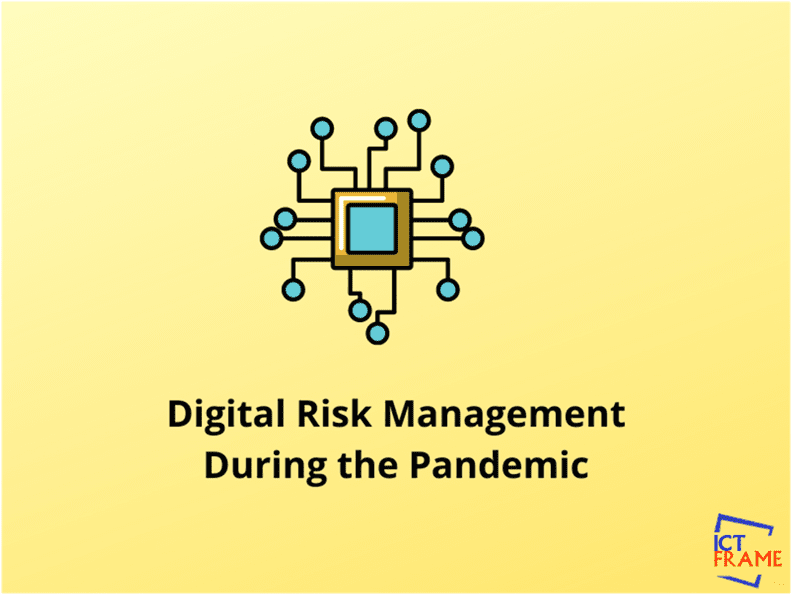Digital Risk Management During The Pandemic
19th September 2020, Kathmandu
Now is the era of digital transformation! From smaller businesses to large enterprises, every sector is today dependent on technology. Especially when the global pandemic covid19 hit the world at the end of 2019 starting from the Chinese Province Wuhan, the dependence on technology and digital infrastructure has become quite indispensable today. In this article, we will look at the changes brought about in the digital domain during the pandemic and how it should be dealt with. The pandemic is still around with us and will stay with us for a long time as per the experts. So, let’s dive deeper into the topic by discussing Digital Risk Management that has become mandatory in today’s time and space.
First, let’s learn in detail about the concepts and definitions of digital risks, its types, and other important aspects related to it.
What is Digital Risk?
Digital risks are the actions or events that can cause damage to the computers, hardware, software, data, and information in a digital domain. Every business or organization is today susceptible to attacks and threats. Every now and then we are hearing about the hackers and cybercriminals attacking and manipulating the data and information they get their hands on.
Types of Digital Risk:
- Cybersecurity Risk
- Compliance RISK
- Workforce Risk
- Third-party risk
- Data Privacy Risk
- Resilience Risk
- Automation Risk
Digital Risk Management:
Digital Risk management is an essential part of business management. Managing digital risk means understanding the loopholes in the business or organization and carrying out the necessary actions to minimize its effect in the business.
Steps of digital risk management:
- Identifying critical/vulnerable business assets: Firstly, an organization needs to know what are the assets(data, information, etc.) that are vulnerable. This paves the way to carry out the further steps.
- Identifying potential threats: After knowing the vulnerable aspects of the business, it is important to analyses what possible threats and risks might affect those vulnerable aspects.
- Monitoring for unwanted exposure: In this step, the organization/business should carry out various steps to know whether the data/business assets are exposed to the outside unwanted world. If they are exposed and attack prone, final actions need to be taken.
- Taking necessary actions: This is the final step in digital risk management. The necessary steps to protect the data and information should be taken in this step. The companies should carry out various mitigating measures. The mitigating measures include:
- Tactical Mitigations
- Operational Mitigations
- Strategic Mitigations
Now, let’s talk about the current pandemic scenario and how digital risk management needs to be strengthened even more today.
Pandemic and Digital Risk:
After the pandemic hit globally, all the organizations and enterprises have started to rely heavily on Technology. It’s great that technology has been incorporated in various aspects of the society, but the rampant adoption without any care for risk and threat assessment has made the organizations and companies even more vulnerable. Time and again, we are hearing various hackers and attackers more pervasive than ever before.
This has definitely shifted the risk to the digital domain today. It is a great task for the organization to manage data security and other various threats.
Industries in risk:
- Banking/Financial Institutions
- Healthcare
- Manufacturing
- Pharmaceutical sectors
- Educational Institutions
The listed industries and much are lacking proper security today. When it comes to the Pharmaceutical industries, attacks could be more rampant considering the worldwide craze and competition for developing the correct vaccine for the virus.
Let’s consider an example of the banking sector which is currently among the most vulnerable businesses.
Online banking and electronic transactions have evolved over the months today. The shift has accelerated at a very fast pace due to the pandemic. But are these things being done correctly? The only goal when the pandemic hit the banking sector was to continue their business. Due to this necessity, proper risk assessment and mitigating measures aren’t done. They are just riding the bandwagon. This can definitely have a negative impact. For risk management, they need to change the framework.
How to make digital systems resilient in the times of pandemic?
- Organizations should be aware that attacks can happen at any time.
- They need to plan accordingly for the unexpected.
- End users are being attacked in their homes. They need to take care of that. Phishing attacks are increasing.
Organizations should adopt digital risk management. During the unprecedented times following steps have become a necessity. Let’s look at them in detail.
How to identify digital risk?
- Perform a routine risk assessment to understand where the company/organization stand
- Implement new technology considering the risk management
- The companies should take care of the data privacy of employees.
- Addressing the employees’ concerns because they are at risk by working remotely.
- Safeguard the overall cybersecurity ecosystem.
- Today the workplace isn’t just centrally located in a building; today everyone is working from home. So, the companies need to evaluate the risks in the employees’ network too.
What steps do the organizations need to take?
- Companies should provide their own laptops and pc with security parameters
- The work from home employees should be trained which has been neglected from time unknown.
- Cybersecurity awareness to employees.
- The employees should be made aware of the potential threats by providing then Phishing simulations.
What lies ahead?
It seems like the pandemic is still going to be among us for a fairly long time. Meanwhile, work from home has become a culture and remote employment is definitely going to continue in the future even after the covid19 pandemic starts to fade away. So, it is an utmost need of today to think about the digital risks and carry out the necessary evaluations and assessments in full swing.
The heavily digitally empowered industries today are the more vulnerable ones and they should come up with the best ideas and measures to ensure that security is maintained. Similarly, cybersecurity or more precisely the digital community as a whole needs to come together in these dire times to find out the best solutions to the problems at hand.
Meanwhile, let us know what needs to be done to ensure digital security in the current scenario in the comments below.

Author: SumanThapaliya
Head of IT Department
Texas College of Management and IT
Recommended Reads:
How to Generate Strong Password through Browser: Firefox, Chrome








